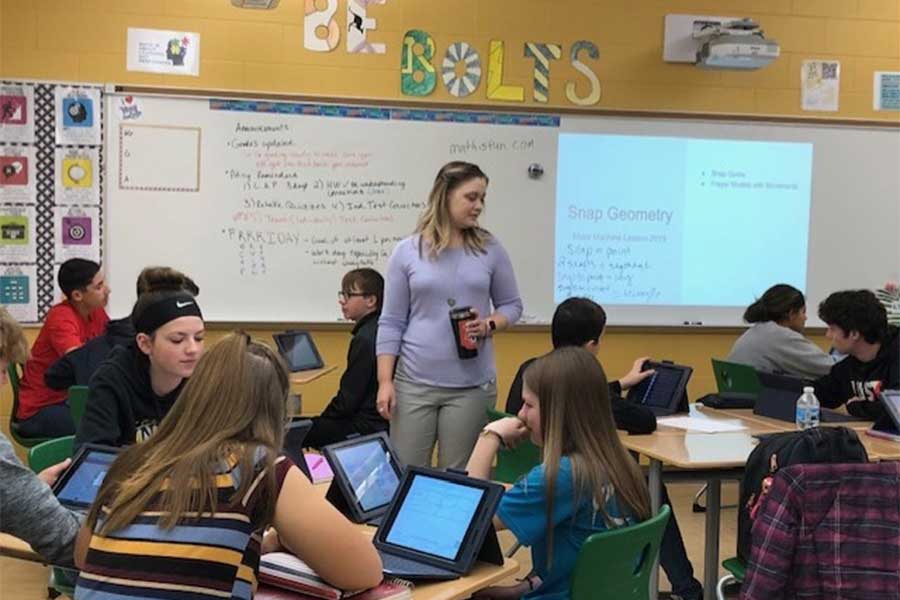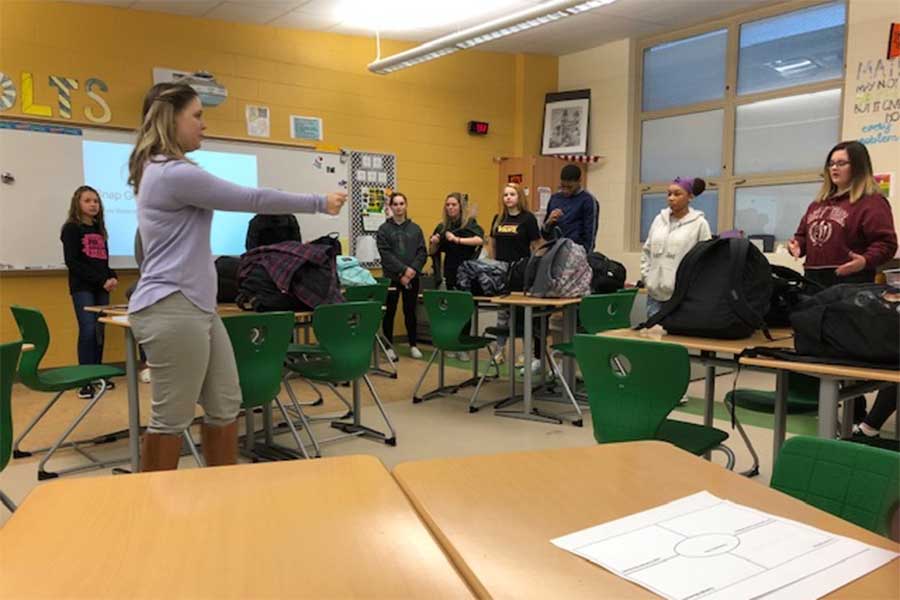Snap Geometry
Developed by Corrinne Fischer
Northmont High School
Geometry
Grade Level: High School
Introduction
Not everyone sees a connection between the arts and mathematics. One creative teacher does it on a consistent basis. Corrinne Fischer, math teacher at Northmont High School, consistently incorporates creative principles into her classroom. During the Muse Machine 2019 Summer Institute, which Corrinne attended, the presenters used ideas throughout the workshop that helped keep participants engaged and aided them in seeing the ways that movement and rhythm can help students remember difficult content. Ping Chong + Company, the guest artists, inspired Corrinne to use the Snap Game to increase understanding of geometry and the use of the Frayer Model. The result is a lesson that can be incorporated into any math teacher’s instructional process. Proof positive that a creative teacher can inspire any subject area!
Click here to view/download this lesson plan as a PDFInspiration
Like many, I was inspired about using circle time to begin each day during the 2019 Muse Machine Summer Institute with Ping Chong + Company. One of the activities we did during this workshop was a snapping game. Not only was this activity engaging and fun, but it did also not require any talking and participants had to focus, listen, and make eye contact: all productive behaviors of an effective classroom environment helping to foster teamwork and respect for fellow classmates.


Overview
Summary
After playing several rounds of the snap game, the teacher will begin a class discussion about how the game’s movements correspond to geometry. Students will use these basic movements and their knowledge of the undefined terms of geometry to create movements and communal (team) definitions for vocabulary words using Frayer Models. After sufficient time to complete the assignment, the class will return to the main circle where small groups will present. A whole class discussion will end the class.
Standards
G.CO.1 Know precise definitions of ray, angle, circle, perpendicular line(s), parallel line(s), and line segment, based on the undefined notions of point, line, distance along a line, and arc length.
SMP #6 Attend to precision. Mathematically proficient students try to communicate precisely to others. They try to use clear definitions in discussion with others and in their own reasoning. They state the meaning of the symbols they choose, including using the equal sign consistently and appropriately. They are careful about specifying units of measure and labeling axes to clarify the correspondence with quantities in a problem. They calculate accurately and efficiently and express numerical answers with a degree of precision appropriate for the problem context. In the elementary grades, students give carefully formulated explanations to each other. By the time they reach high school they have learned to examine claims and make explicit use of definitions.
Objectives/Outcomes
I can use snaps and movements to represent vocabulary words.
I can collaborate and communicate effectively with my team to build Frayer Models.
Teaching Approach
workshop
Assessment
- Student groups will complete a Frayer Model for their assigned/chosen geometric terms.
- A “C” rubric is given to students, but a full rubric can be used as well.
- The student groups will complete self and peer evaluations.
Lesson Preparation
Teacher Needs
-Ample space for whole class circle
-Timer
-Document camera
-Patience
Teacher Information
My students were already aware of circle time and the snap game. Play a few times “randomly” before implementing this lesson. Though it was my full intention to present a list of vocabulary terms for students to choose from, I thoroughly enjoyed allowing the teams to brainstorm a list of words they have learned. It brought an extra level of student voice to this lesson. Also, if your classroom environment does not support a “bidding war,” simply use a multi-sided number cube or random number generator to choose teams.
Helpful Hints
Let go! It is so hard for us to give up control in our classrooms but sometimes it is so worth it! Setting timers really helped them stay on task and allowed me to circulate the room as teams worked.
Student Needs
-Access to notes, dictionary, etc. to look up formal definitions
-Writing utensils
Prior Knowledge
This is an introduction to staging a production. However, a general understanding of what is involved in a stage, how stages are used, and the general limitations of stages would be helpful.
Student Voice
Choice of words and movements.
Vocabulary
Your choice! Use whatever mathematical language is appropriate to your lesson.
Evidence/Assessment of Outcomes
Students’ completed Frayer Models, rubrics and the teacher’s participation rubric
Enduring Understandings
Mathematics is a finite subject but there is flexibility in the ways it can be used.
Learning Plan
Prompt
After snap game is played. Teacher: What could a snap represent in Geometry?
Hooks
Play the snap game as a community building tool or warm-up before adding in mathematical concepts.
Essential Questions
- How can snaps and movements represent words?
Teacher and Student Performance Tasks
The snap game as demonstrated by Ping Chong + Company started with a single person in the center. They snap, with their hand close to their chest, then “throw” the snap to someone in the circle, making eye contact, and snapping to “point” at them. This person “catches” the snap and “throws” it back to the center. This continues randomly within the circle until the center person decides to end the game. Variations include no person in the center, adjustments for those who cannot snap, and sending multiple snaps.
Whole Class Warm-up Snap Game
- Version 1 with teacher in center
- Version 2 as full circle
- Version 3 with smaller groups (2-3 teams per circle)
- Version 1 repeats
Whole Class Discussion in circle about objectives
- Project assignment requirements and “C” rubrics distributed
Small Group Work time
- Teams choose their vocabulary words
- Give them a list or let them brainstorm their own list
- Teams should not complete the same words. You can “bid” for words if time allows
- Teams create and practice movements and complete Frayer Models
Final Review
Whole Class
- Concentric circles sharing with one student team in the middle
- Team’s Frayer Model projected on screen with document camera
- Team presents movement together
- Reporter reads term and communal (team) definition, explains connections between movements and their definition.
Lesson Reflection
As there are so many concepts and vocabulary terms in Geometry as a whole, it is challenging to see enduring understanding without giving a vocabulary quiz. However, the students were talking about the lesson the next day and students in other classes were upset that they did not get to participate. I am planning on revamping how vocabulary is used throughout the rest of the year in all my classes using similar ideas from this lesson. Ideally, I would have three days like this per unit: one at the beginning of the unit, one in the middle and one at the end. You could even give them back their same Frayer Models or give them to other teams to critique.

